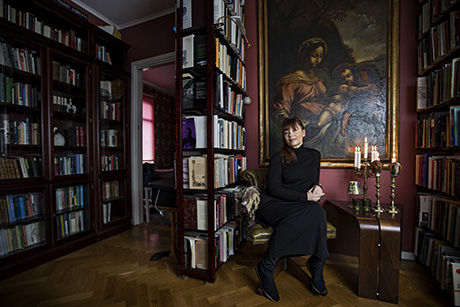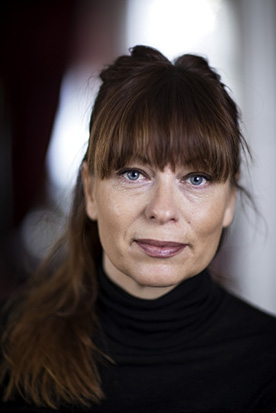- Home
- News and events
- Find news
- With a digital focus on humanities
With a digital focus on humanities
“Digital technology is a lens that helps us rediscover cultural history,” explains Cecilia Lindhé, director of the Centre for Digital Humanities.
She herself had the opportunity to unite new technology with mediaeval images when she worked with a digital installation on the Virgin Mary.
 Becoming the director of the Centre for Digital Humanities last year brought Cecilia Lindhé new opportunities for her research to use digital technology, something she has been busy with for almost twenty years. It also means that, for the first time in many years, she is living and working in the same town.
Becoming the director of the Centre for Digital Humanities last year brought Cecilia Lindhé new opportunities for her research to use digital technology, something she has been busy with for almost twenty years. It also means that, for the first time in many years, she is living and working in the same town.
“While I was a PhD student, I commuted between Karlskrona and Uppsala. When I took my doctoral degree in 2008, I had already got an appointment as an assistant director of Humlab in Umeå. I was living in Skåne at the time and continued to commute up until 2010. I then moved to Gothenburg and started travelling from there instead. Thus, always being on the way somewhere became a part of my lifestyle. However, now living and working in Gothenburg, as well as also being able to walk to my job if the weather is nice, is, of course, of great value.”
The interest started early
Cecilia Lindhé’s interest in digital technology started as early as when she was reading literary studies at Blekinge Institute of Technology. There, everything (the humanities included therein) had to have a connection to technology.
“I started researching Kerstin Ekman and, to my surprise, discovered that this major author was also interested in digital technology. Amongst other things, she compiled a database on the history of her hometown in Jämtland. During long, boring trips to the Swedish Academy, she studied programming. In 1991, she even created a computer game, Rymdresa (‘Space Odyssey’). Computer Sweden voted it ‘the year’s Christmas present’. It involved, amongst other things, closely reading Stanislaw Lem’s The Invincible and answering questions such as ‘what is a theodolite?’ However, the game is only on diskette. This illustrates one problem with modern technology – it ages very quickly. Still, the computer game is now part of another project in which Cecilia Lindhé is involved. This is on how digitalisation has affected Swedish art and literature over the past 50 years.”
In her doctoral thesis, Visual Variations: Image and Aesthetics in Kerstin Ekman’s Novels, Cecilia Lindhé showed that Kerstin Ekman’s novels were inspired by other media, not least films and computer games.
“Kerstin Ekman came to the public defence of my doctoral thesis and sat on the front row. Of course, this was very special. She was incredibly friendly. She then even sent me a touching three-page letter in which she related my thesis to various events in her life.”
The Virgin Mary as a role model
Digital tools have followed Cecilia Lindhé over the years. Take, for example, Imitatio Mariae. Jungfru som förebild i det medeltida Sverige (‘Imitatio Mariae – the Virgin Mary as a role model in mediaeval Sweden’).
“This was an interdisciplinary project at Umeå University. I was working with a historian, a Scandinavian philologist and an art historian. For four years, we travelled around Uppland, Östergötland and Gotland documenting some hundred mediaeval churches. I took almost 8,000 pictures. These later resulted in an interactive installation at Humlab in Umeå. The photos were shown on large screens and were sensitive to touch, sound and light. The idea was to lessen the focus on text and to create a feeling of how images, texts, light, touch and space are interdependent.”
Mediaeval people saw the Virgin Mary as a mediator between man and God. She served as a yardstick, even if it was impossible to be equally perfect. However, the Reformation and the suppression of everything Catholic then came. Thus, at the start of the 20th century, in a stocktaking of Swedish churches, images of Mary were found stashed in all sorts of places – in old chests, up in church towers and in somewhat hidden away cabinets in village schools.
Mary still excites debate. Is she a servile, patriarchal invention or a female role model in an otherwise male-dominated religion?
“I, myself, am fascinated by her. For many years, I have collected images, large and small, of Mary.”
Swedes on Malta
Her digitalisation interest has also led Cecilia Lindhé to research completely different matters elsewhere in the world. Amongst other things, she has grown interested in the destinies and adventures of Swedes on Malta. Her research has concentrated on the Gollcher family. Leaving Danzig in the middle of the 18th century, the family came to Gothenburg and set up a cooperage. The family then moved to Stockholm and got involved in ship building and shipping. In 1848, Johan Gustaf Gollcher sailed aboard the brig Swalan to Malta. There, his son became the Swedish consul.
“This position has since been passed through the family all the way to the present holder, Karl Gollcher. I became interested in this family because, a few years ago, Karl contacted me for help with a question he had received from the Museum of Mediterranean and Near Eastern Antiquities in Stockholm. The museum wanted to know more about a gold label that had accompanied an Egyptian mummy which a Mr Gollcher on Malta appeared to have ordered for the Swedish king in 1870.”
Along with an Egyptologist at the museum, Cecilia Lindhé finally managed to solve the riddle of the mummy and how it ended up in Stockholm. Immediately after this, she learned that Karl Gollcher’s garage held two unopened wooden boxes with material from 1822 onwards.
“Naturally enough, I travelled down and started to investigate the boxes. They contained diplomatic correspondence, documents about Swedish sailors, diaries, tiny crib sheets in preparation for a royal visit and all manner of other things. I now hope to have the opportunity to digitalise and make this material accessible. Most immediately, I’ll be trying not only to write a book about the Gollcher family, but also to work on a project about Scandinavian visitors to Malta, 1650 to 1950.”
Moravian Memoirs
Another project in which Cecilia Lindhé is involved is Moravian Memoirs. This deals with Moravianism, a Christian movement that started in 1727 in the German town of Herrnhut.
“One of the movement’s central ideas was that all members of the congregation should write their own biographies. Thirty thousand such texts are stored in an archive in Herrnhut and just as many in Betlehem in Pennsylvania (where many of the congregation had moved). Together with Bucknell University in the USA, the Centre for Digital Humanities is working on compiling information about these 60,000 people and a map showing their movements worldwide. We eventually hope to be able to digitalise the stories themselves.”
A project about Ivar Arosenius
 Yet another project is about the artist Ivar Arosenius. This project is taking digital material from various archives and heritage institutions and collecting them in a new sort of archive. Here, it will be possible to climb into a digital reconstruction of the artist’s home. This will be created from his paintings and material from the archive.
Yet another project is about the artist Ivar Arosenius. This project is taking digital material from various archives and heritage institutions and collecting them in a new sort of archive. Here, it will be possible to climb into a digital reconstruction of the artist’s home. This will be created from his paintings and material from the archive.
“Unfortunately, the house has been demolished and is soon to be replaced by a car wash. However, the project will create a digital version. Jonathan Westin at the Department of Conservation and Dick Claesson at Litteraturbanken (the ‘Literature Bank’) are devoting themselves to this.”
"Analogue and digital does not oppose each other"
Even if Cecilia Lindhé is happy to speak about the digital humanities, the title can create an unnecessary polarisation in which the ‘traditional’ humanities are opposed to ‘the new’ digital humanities.
“Many people believe that analogue and digital oppose each other, as if those interested in digitalisation would want to do away with all physical books. However, that’s not at all how it is. On the contrary, digitalisation means we can rediscover books, not only as the containers of texts but also as a way of giving shape to ideas. Safeguarding the diversity of ideas is not a question of sentimentality, it simply gives us the opportunity to gain insights into unexpected sides of our cultural heritage.”
The roots of digital humanities at the University of Gothenburg go back a long way. Språkbanken (the Swedish Language Bank) was set up in 1975 and Litteraturbanken has been around since 2003.
“However, there’s a lot to do in this area. Digital humanities, as a subject, is often described as a development of new digital methods. Nonetheless, it really hasn’t ever been just about databases, technologies and tools. Personally, I’m very happy to explore other areas such as visualisation, interfaces and epistemological perspectives. Obviously enough, it is also important to have a critical approach to the technology and the ways it creates and arranges information as well as how it gives new perspectives to history.”
Not surprisingly, work, home and family take the major part of Cecilia Lindhé’s time. Yet, she also tries to keep up with another interest that is not work-related.
“I’ve had a passion for Tommy Körberg since I was twelve years old and try to go to at least a couple of concerts a year. People aren’t usually aware that he has created a good many highly personal and reflective interpretations of Swedish poetry by, amongst others, Harry Martinson, Birger Sjöberg, J.O. Wallin, Siv Arb, B.E. Jonsson and Bruno K. Öijer. When, three years ago, he staged Sjung tills du stupar (‘Sing until you drop’) at Intiman in Stockholm, his producer rang and asked if I could put together a programme booklet in words and pictures. The producer explained: ‘Not even Tommy Körberg himself knows as much about him as you.’ I couldn’t refuse.”
More about Cecilia Lindhé
Work: Director of the Centre for Digital Humanities.
Projects – Finished: Imitatio Mariae – the Virgin Mary as a role model in mediaeval Sweden. Ongoing: Representationer och omkonfigureringar av det digitala i svensk konst och litteratur 1950–2010 (‘Representations and reconfigurations of the digital world in Swedish literature and art, 1950-2010’) led by Jesper Olsson of Linköping University; Hur frammanas konstnären ur arkiven? Exemplet Arosenius (‘How to conjure the artist from the archive? For example, Arosenius’) led by Mats Malm; and, Moravian Memoirs: Tracing Movements and History of the Moravian Church (1750 – 2012), led by Christer Ahlberger.
Interests: Songs and music. Has an almost complete collection of Tommy Körberg’s vinyl releases, bootlegs and memorabilia. Is hereby advertising for the single Igor the Dog, released in Japan in 1968!
You didn’t know: Cecilia Lindhé started to take singing lessons when she was ten. As an upper-secondary school student, she planned to become an opera singer.
TEXT: Eva Lundgren
PHOTOS: Johan Wingborg
The interview was first published in GU-Journalen.